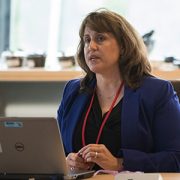Research partnerships and capacity building in the time of COVID-19

“COVID infection anywhere in the world is COVID infection everywhere in the world,” said John Nkengasong, M.Sc., Ph.D., director of the Africa Centers for Disease Control (Africa CDC), during his remarks on the importance of shared science, innovation and diplomacy. Leading experts in global health met virtually on November 13, 2020, to discuss updates in the COVID-19 crisis and lessons learned in Africa. Children’s National Hospital, along with the George Washington University (GW) Institute for Africa Studies and the CNRS-EpiDaPo Lab, sponsored the half-day conference that captured the interest of international attendees committed to examining how best to expand strong and enduring partnerships between U.S. and African scientists, health professionals and research institutes to meet global challenges.
Trust, transparency and communication were common themes of expert panelists that included Elizabeth Bukusi, Ph.D., M.P.H., Kenya Medical Research Institute; Maryam DeLoffre, Ph.D., GW Humanitarian Action Initiative; Peter Kilmarx, M.D., National Institutes of Health (NIH) Fogarty International Center; Enock Motavu, Ph.D., Makerere University in Uganda; Jennifer Troyer, Ph.D., Human Health and Heredity in Africa Program (H3Africa) at NIH; Désiré Tshala-Katumbay, M.D., Ph.D., National Institute of Biomedical Research in Kinshasa; Eric Vilain, M.D., Ph.D., Center for Genetic Medicine Research at Children’s National, with Institute for African Studies Director Jennifer Cooke, and Jonathan LoTempio Jr and D’Andre Spencer of Children’s National as moderators and co-conveners. Read more about the panelists.
The keynote speaker, Nkengasong, updated the group on the massive efforts in bending the COVID-19 disease curve on the African continent which at present has two million cases and 46,000 deaths. This is fewer than many other regions, and Nkengasong attributes this in part to health systems strengthening and capacity building that already occurred with past pandemics like Ebola. He stressed the importance of focusing on the “4 Ps” — population, pathogen, politics and policy — in fighting the pandemic, and the need to ensure that citizens trust their leaders and the public health measures they advance. New endeavors by the Africa CDC include the Pathogen Genomic Initiative, which will help inform research and responses to COVID-19 and other emergent disease threats, and the African COVID-19 Vaccine Development and Access Strategy, which aims to ensure widespread access, delivery and uptake of effective vaccines across Africa. Africa CDC is surging to hotspots as lockdowns ease or shift, and is empowering universities to invest in proactive and, which has helped with the active response success. “Rising tides raise all boats in the sea,” said Nkengasong. He went on to say that there is great power in coordination and cooperation, and science diplomacy and technology are critical to winning the novel coronavirus war.
In a panel on research partnerships, speakers Motavu, Tshala-Katumbay, and Vilain emphasized the global benefits of scientific collaborations in Africa. Africa contains more human genetic variation than any other region of the world, and capturing that diversity in global understanding of the human genome — which is still heavily skewed toward individuals of European ancestry — will be a major factor in global medical advances of the future. And research into relatively localized diseases can lead to breakthroughs in broader understanding on connections between climate variation, environment, nutrition and child health. “The simplistic, localized, nationalist, way of doing science is over,” said Tshala-Katumbay, “and there is no way to go back.” The discipline of science diplomacy will take time for people to grasp, he added, “but it will be crucial for the future generation of scientists to go back.”
A recurring conference theme was that collaboration between countries is crucial for development of better care. Kilmarx told the event participants that in 2019, the National Institutes of Health supported some 1,668 collaborations with African research institutions. Investments in capacity building have yielded impressive results, and today some of Africa’s foremost leaders in science research and public health have received NIH training and support, stating: “If you plant acorns over the decades, you have some mighty oaks.” Bukusi, once such NIH trainee, now is engaged in training a new generation of African researchers and U.S. researchers based in Africa and expanding research partnerships at the Kenya Medical Research Institute.
Troyer showed the successes of the Human Heredity and Health in Africa Initiative, a large consortium that supports a pan-continental network of laboratories that aims to determine disease susceptibility and drug responses. Finally, DeLoffre underscored the need for long-term investments and the value of building local capacities to respond to current crises and anticipate future challenges.
Overall, there was optimism that innovative coalitions are a long-term strength in fighting pandemics and promoting reciprocal learning that will last after the crisis. Science can be a neutral platform that, combined with diplomacy and technology, builds bridges between peoples.









